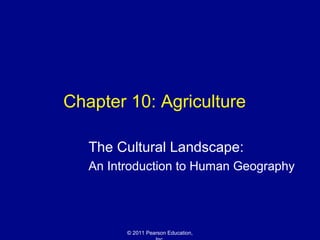
Tcl 10e lecture_ch10
- 1. Chapter 10: Agriculture The Cultural Landscape: An Introduction to Human Geography © 2011 Pearson Education,
- 2. Where Did Agriculture Originate? • Origins of agriculture – Agriculture = deliberate modification of Earth’s surface through the cultivation of plants and/or rearing of animals – Cultivate = “to care for” – Crop = any plant cultivated by people © 2011 Pearson Education,
- 3. Where Did Agriculture Originate? • Origins of agriculture – Hunter-gatherers • Perhaps 250,000 remaining today – Invention of agriculture • When it began = unclear • Diffused from many hearths © 2011 Pearson Education,
- 4. Crop Hearths Figure 10-2 © 2011 Pearson Education,
- 5. Animal Hearths Figure 10-3 © 2011 Pearson Education,
- 6. Where Did Agriculture Originate? • Commercial and subsistence agriculture – Subsistence = produced mainly for the farm family’s survival • Most common in LDCs – Commercial = produced mainly for sale off the farm • Most common in MDCs © 2011 Pearson Education,
- 7. Agriculture and Climate Figure 10-4 © 2011 Pearson Education,
- 8. Where Did Agriculture Originate? • Commercial and subsistence agriculture – Five characteristics distinguish commercial from subsistence agriculture • Purpose of farming • Percentage of farmers in the labor force • Use of machinery • Farm size • Relationship of farming to other businesses © 2011 Pearson Education,
- 9. Agricultural Workers Figure 10-5 © 2011 Pearson Education,
- 10. Area of Farmland Per Tractor Figure 10-6 © 2011 Pearson Education,
- 11. Where are Agricultural Regions in LDCs? • Shifting cultivation – Most prevalent in low-latitude, A-type climates – Two features: • Land is cleared by slashing and burning debris – Slash-and-burn agriculture • Land is tended for only a few years at a time – Types of crops grown vary regionally – Traditionally, land is not owned individually © 2011 Pearson Education,
- 12. Where are Agricultural Regions in LDCs? • Pastoral nomadism (herding domesticated animals) – Found primarily in arid and semiarid B-type climates – Animals are seldom eaten • The size of the herd indicates power and prestige – Type of animal depends on the region • For example, camels are favored in North Africa and Southwest Asia – Transhumance practiced by some pastoral nomads © 2011 Pearson Education,
- 13. Where are Agricultural Regions in LDCs? • Intensive subsistence – Found in areas with high population and agricultural densities • Especially in East, South, and Southeast Asia • To maximize production, little to no land is wasted – Intensive with wet rice dominant – Intensive with wet rice not dominant © 2011 Pearson Education,
- 14. Rice Production Figure 10-12 © 2011 Pearson Education,
- 15. Where are Agricultural Regions in LDCs? • Plantation farming – Found in Latin America, Africa, and Asia – Products are grown in LDCs but typically are sold to MDCs – Plantations specialize in one or two cash crops • Important crops = coffee, sugarcane, cotton, rubber, and tobacco – A large labor force is usually needed in sparsely settled regions © 2011 Pearson Education,
- 16. Where are Agricultural Regions in MDCs? • Mixed crop and livestock farming – Most land = devoted to crops – Most profits = derive from the livestock • Dairy farming – Regional distribution: the milkshed – Two primary challenges • Labor-intensive • Expense of winter feed © 2011 Pearson Education,
- 17. Corn (Maize) Production Figure 10-15 © 2011 Pearson Education,
- 18. Milk Production Figure 10-17 © 2011 Pearson Education,
- 19. Where are Agricultural Regions in MDCs? • Grain farming – The largest commercial producer of grain = the United States • Livestock ranching – Practiced in marginal environments • Mediterranean agriculture – Based on horticulture • Commercial gardening and fruit farming – Truck farms © 2011 Pearson Education,
- 20. Wheat Production Figure 10-19 © 2011 Pearson Education,
- 21. Meat Production Figure 10-21 © 2011 Pearson Education,
- 22. Why Do Farmers Face Economic Difficulties? • Challenges for commercial farmers – Access to markets is important • The von Thünen model (1826) – The choice of crop to grow is related to the proximity to the market Figure 10-24 © 2011 Pearson Education,
- 23. Why Do Farmers Face Economic Difficulties? • Challenges for commercial farmers – Overproduction • Agricultural efficiencies have resulted in overproduction • Demand has remained relatively constant – As a consequence, incomes for farmers are low – Sustainable agriculture • Sensitive land management • Integrated crop and livestock © 2011 Pearson Education,
- 24. Why Do Farmers Face Economic Difficulties? • Challenges for subsistence farmers – Population growth – International trade – Drug crops © 2011 Pearson Education,
- 25. Drug Trade Figure 10-27 © 2011 Pearson Education,
- 26. Why Do Farmers Face Economic Difficulties? • Strategies to increase food supply – Expanding agricultural land • Desertification – Increasing productivity • The green revolution – Identifying new food sources • Cultivating oceans, developing higher-protein cereals, and improving palatability of foods – Increasing trade © 2011 Pearson Education,
- 27. Agricultural Land and Population Figure 10-28 © 2011 Pearson Education,
- 28. Grain Imports and Exports Figure 10-32 © 2011 Pearson Education,
- 29. The End. Up next: Industry © 2011 Pearson Education,
